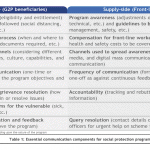The Missing Link in the Blockchain: The Need for Trust in a ‘Trustless’ System
Blockchain has become the ultimate buzzword, and organizations across the global development sector are seeking to apply the technology in projects of every stripe. But as our team researched blockchain for social impact earlier this year for Stanford, it quickly became apparent to us that verifiable digital identification for individual people was a much-needed precursor to many proposed blockchain initiatives.
Governments need to identify eligible voters and beneficiaries of public services. Healthcare providers need to consistently and correctly identify patients. Banks need to identify account holders and beneficial owners to comply with know-your-customer (KYC) rules for financial transactions. For me, these needs brought up two related questions: Who or what might be legitimately in charge of validating the first entry into a ledger (the shared database held and updated independently by participants in a distributed network – the basis of blockchain technology). And how can these validating entities, or the process they use, be trusted?
In whom do we trust?
At first glance, the need for trust in an offline authority seems to undermine the promise of blockchain as a trustless and completely transparent process. Blockchain solutions are seen by many as a way to obviate the need for formal, centralized oversight. But certain rights, like voting or banking, do, at their core, need sanction from recognized authorities. And the stakes are high: The rise of nationalism in response to refugee crises across Europe and the Americas, along with ongoing hostile-state attempts to compromise democratic elections, show the heavy burden and controversial nature of determining who is worthy of citizenship, and how we confirm identity across borders.
Meanwhile, trust in government remains near an all-time low in the United States, where only 18 percent of citizens report that they trust government “just about always” or “most of the time.” Globally, a median 52 percent of people are not satisfied with their government. Even if these trends don’t imply a total crisis of faith in government, the numbers indicate that it falls short as a universally trustworthy, authoritative entity.
Trust in government is also crucial for blockchain projects seeking to promote social good, as are in-person assessments of property. When I spoke with an interviewee at Sweden-based Chromaway for our research, he allowed that Swedes’ high trust in their government made work on digital identification and land tenure registration in Sweden a lot easier. And an official in the Republic of Georgia’s National Agency of Public Registry told me that a key part of their verification process prior to registering land on the bitcoin blockchain included searching archives or even turning to the courts, in cases where ownership was undocumented, unclear or disputed.
The verifiability built into blockchain systems will mean nothing if the inputs can’t be trusted. Without careful verification of truth by blockchain implementers – and trust in those implementers by the public – blockchain will offer nothing more than the many digitization initiatives already underway for public records around the world.
Identity for places and things
During my research, one person told me there were three types of entities that needed a verifiable digital ID: people, corporations and machines (eg: computers, ATMs, robots). These seem to adequately represent the potential transactors on a blockchain system, but what about the object or entity being transacted? In other words, even if we accept that corporations and machines – like people – may have legal personhood that allows them to be given a verifiable digital ID, we’d still need to account for places and things.
Many of the initiatives proposed by global development players would require identification beyond the transactor level: Supply chain transparency and efficiency initiatives need a way to attach an identification to products or materials based on where, from whom and under what circumstances they were sourced. Land registration on a blockchain requires verification that the land exists, has been accurately surveyed and isn’t subject to competing claims – by neighbors in real life, not just potentially registered counter claims in a blockchain system or the legacy system on which it is based.
The first entry into a blockchain (or distributed ledger system) of the thing being transacted requires some sort of human verification process; perhaps a functioning judicial system or an authorized regulatory procedure carried out by a competent regulator. Supply chain verification might use third-party verification systems, like those for sustainable forestry, responsible palm oil or fair trade – though these may also be seen as a suboptimal stand-in for a fully capable government. Human verification is also necessary for the resolution of any conflicts over the item being transacted – from recourse for commercial fraud to resolution of inheritance disputes. Fundamentally, this designation would come down to enforceable and verifiable property rights: How do we decide who legitimately owns and is allowed to transact what?
Generally, the answer to this question is government: Even the most conservative views on the role of the state include enforcement of property rights. When property is being created (“mined”) in the context of a virtual currency like bitcoin, ownership is assigned based on transparent, code-based processes, and value is assigned based on the market. Most property on the planet, however, is spoken for, or claimed in some way. And the claims over property and rights to natural resources are far from resolved: Even the frontier areas of the Arctic and the deep sea are subject to fierce competition and conflicting claims among countries.
Learning from existing models
Perhaps some of the lessons from the world’s most advanced blockchain-in-government experiment can be useful here. A technologist from Guardtime, the service-provider for the E-Estonia system – and perhaps more importantly, an Estonian who witnessed the roll-out from a citizen’s perspective – highlighted for me in our interview the need for a gradual, trust building process in any new government-operated system, especially a technically-complex one like blockchain. His advice: Build in time for initial distrust, take a stepwise approach and allow for transparency throughout the process – especially when dealing with setbacks or scandals.
However, the Estonia model may not be easily replicable in other countries. With a population of less than 2 million, Estonia may have been able to move more quickly than larger (and less digitally-connected) nations. And the type of public trust-building process which Estonia achieved also necessitates a free and professionalized press and a free and engaged citizenry – two things you don’t find in all countries.
So the question remains: Before we enshrine information about a citizen, a process or a property right into an immutable, transparent and (by some measures) permanent ledger – in whom or in what can we trust? The answer to this question lies somewhere between our faith in formal government processes, our access to justice and recourse, and our ability to hold our own governments accountable. Blockchain can be a powerful tool for social good. To have maximal positive impact, blockchain practitioners need to ensure that their ambitious initiatives bridge the gap between the authority and power of governments and the needs and pursuits of their peoples.
Rose Davis is an MA student in International Policy Studies at Stanford School of Humanities & Sciences.
Image courtesy of Joey Kyber.
- Categories
- Technology



